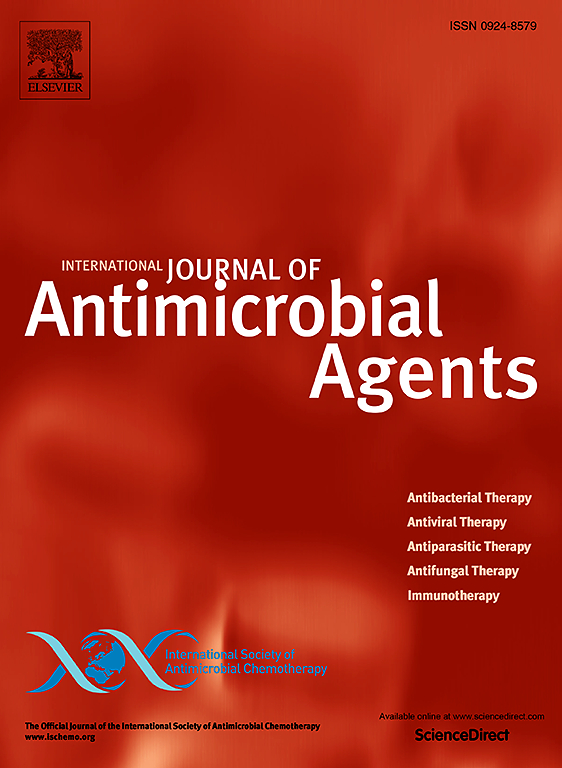Subminimum inhibitory concentrations of rifampicin attenuate methicillin-resistant staphylococcus aureus virulence by suppressing SaeRS two-component system and arginine metabolism-related pathways
IF 4.6
2区 医学
Q1 INFECTIOUS DISEASES
International Journal of Antimicrobial Agents
Pub Date : 2025-02-03
DOI:10.1016/j.ijantimicag.2025.107459
引用次数: 0
Abstract
Objectives
Methicillin-resistant Staphylococcus aureus (MRSA) poses a significant threat to global public health, prompting the exploration of alternative strategies to mitigate its virulence. This study investigates the impact of subminimum inhibitory concentrations (sub-MICs) of rifampicin on MRSA virulence, aiming to provide insights for optimizing antibiotic treatment strategies.
Methods
Enzyme-linked immunosorbent assay and western blot analysis were used to assess α-hemolysin expression. Transcriptomic sequencing and RT-qPCR analyzed gene expression changes in MRSA treated with sub-MICs of rifampicin. Mutant strains (ΔsaeR and ΔargGH) were constructed to validate the roles of the SaeRS system and arginine metabolism. Thermal shift assays evaluated the interaction between L-arginine and SaeR protein. In vivo murine models and Galleria mellonella infection models were used to assess the anti-virulence effects of rifampicin.
Results
Our findings reveal that sub-MICs of rifampicin significantly reduce the expression of MRSA α-hemolysin. Transcriptomic sequencing and RT-qPCR analysis suggest a dual-pathway mechanism, wherein rifampicin suppresses virulence by indirectly inhibiting the SaeRS two-component system and disrupting arginine metabolism-related pathways. The construction of a saeR knockout mutant (ΔsaeR) and an arginine biosynthesis deficient mutant (ΔargGH) further supports this mechanism. Notably, exogenous l-arginine supplementation reverses rifampicin's inhibitory effect on α-hemolysin expression, underscoring the pivotal role of l-arginine metabolism in MRSA virulence regulation. Thermal shift assays demonstrate a direct interaction between l-arginine and SaeR protein, elucidating the intricate interplay between metabolic pathways and virulence regulation. In vivo studies confirm that sub-MICs of rifampicin attenuate the severity of skin abscesses in a murine model, improve survival rates in bloodstream infection models, and mitigate inflammation in both skin and lung tissues.
Conclusion
This study highlights the potential of rifampicin as an anti-virulence agent and pave the way for the development of innovative therapeutic strategies targeting MRSA infections.

亚最低抑菌浓度利福平通过抑制SaeRS双组分系统和精氨酸代谢相关途径减弱耐甲氧西林金黄色葡萄球菌的毒力。
耐甲氧西林金黄色葡萄球菌(MRSA)对全球公共卫生构成重大威胁,促使人们探索减轻其毒力的替代策略。本研究探讨利福平亚最低抑菌浓度(sub- mic)对MRSA毒力的影响,旨在为优化抗生素治疗策略提供见解。我们的研究结果表明,利福平的亚mic可显著降低MRSA α-溶血素的表达。转录组测序和RT-qPCR分析表明,利福平通过间接抑制SaeRS双组分系统和破坏精氨酸代谢相关途径来抑制毒力。saeR敲除突变体(ΔsaeR)和精氨酸生物合成缺陷突变体(ΔargGH)的构建进一步支持了这一机制。值得注意的是,外源性补充l -精氨酸逆转了利福平对α-溶血素表达的抑制作用,强调了l -精氨酸代谢在MRSA毒力调节中的关键作用。热移实验证明了l -精氨酸和SaeR蛋白之间的直接相互作用,阐明了代谢途径和毒力调节之间复杂的相互作用。体内研究证实,利福平的亚mic减轻了小鼠模型中皮肤脓肿的严重程度,提高了血流感染模型中的存活率,并减轻了皮肤和肺组织的炎症。这项研究强调了利福平作为一种抗毒剂的潜力,并为开发针对MRSA感染的创新治疗策略铺平了道路。
本文章由计算机程序翻译,如有差异,请以英文原文为准。
求助全文
约1分钟内获得全文
求助全文
来源期刊
CiteScore
21.60
自引率
0.90%
发文量
176
审稿时长
36 days
期刊介绍:
The International Journal of Antimicrobial Agents is a peer-reviewed publication offering comprehensive and current reference information on the physical, pharmacological, in vitro, and clinical properties of individual antimicrobial agents, covering antiviral, antiparasitic, antibacterial, and antifungal agents. The journal not only communicates new trends and developments through authoritative review articles but also addresses the critical issue of antimicrobial resistance, both in hospital and community settings. Published content includes solicited reviews by leading experts and high-quality original research papers in the specified fields.

 求助内容:
求助内容: 应助结果提醒方式:
应助结果提醒方式:


